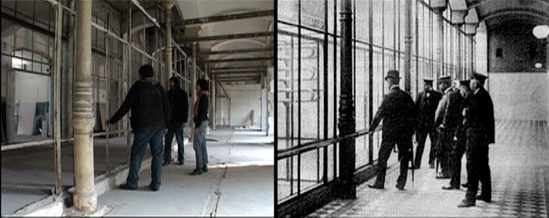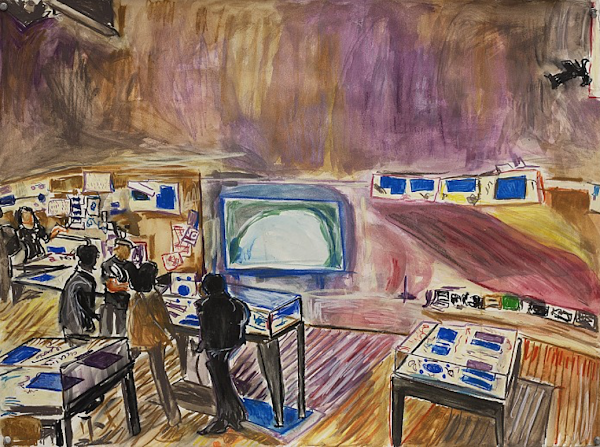RISD is pleased to announce the receipt of the single largest gift ever from an international donor: $1 million to create an endowed fund in support of the Vikram and Geetanjali Kirloskar Visiting Scholar in Painting.
Mining the Margins
RISD students and faculty packed into the Chace Center’s Metcalf Auditorium last Thursday evening for a screening of The Capital of Accumulation (2010), an experimental diptych/film by artists-in-residence Raqs Media Collective made to raise questions about capitalism and murdered Marxist revolutionary Rosa Luxemburg. As this year’s Vikram and Geetanjali Kirloskar Visiting Scholars in Painting, the three Indian artists who make up Raqs – Jeebesh Bagchi, Monica Narula and Shuddhabrata Sengupta – have been working with students in the museum’s Lower Farago Gallery since mid March, exploring notions of narrative and counter-narrative and the power of notations relegated to the margins.
“If you look at diagrammatic representations of conversation, there is no center. Everything is equally important and links to everything else.”
“What constitutes the center and what constitutes the margins?” Narula asks. “If you look at diagrammatic representations of conversation, there is no center. Everything is equally important and links to everything else.”
Students enrolled in the collective’s three-week studio, A Myriad Marginalia, responded to a series of exercises intended to open up the dialogue about margins and marginalization – as a means of making new points of connection that steer the narrative in new directions. “The idea of a homogenous vision of the world – a monolithic discourse – is extremely problematic,” Narula notes.

“We’re thinking about the categories of ‘margin’ and ‘center’ in all sorts of ways,” Sengupta adds – “the center of the world, of a drawing process, how a work is bracketed by time…. It’s all about the process, not the objects students are producing. We’re collecting traces of the work we’re doing.”
Painting professors Dennis Congdon 75 PT and Holly Hughes, who oversee the Kirloskar Visiting Scholars program, knew that a residency by Raqs would resonate at RISD. “We’re practicing artists,” says Narula, “but we try to participate in an intensive [teaching] experience like this once a year. We originally met Holly in Moscow. We’d been in Providence a couple of years earlier for a conference at Brown and led a conversation at [RISD’s Fleet] library organized by [Associate Professor of Digital + Media] Kelly Dobson and [Assistant Professor of Literary Arts + Studies] Avishek Ganguly.”
The trio has been working together to engage in “kinetic contemplation” since 1992, traveling the world to present their experimental films, installations and conceptual projects. Their work has been selected for inclusion in this year’s Venice Biennial, which opens next month. And their residency at RISD culminated last week with an exhibition of work students created in response to the notion of marginalia and to the color blue (or indigo) as a symbol of colonialism, repression and (in Sengupta’s words) “the global uniform of modernity.”
The exhibition and screening of The Capital of Accumulation (part of the museum’s ongoing Projections series) were followed by a free-wheeling discussion that began with questions about the piece – its framing and content, the dissonance created by competing audio and visual elements – and ended with musings on the notions of nothingness and infinitude. “We filmed the piece over the course of a year and a half,” Bagchi explains. “It’s neither for nor against globalization. We are just trying to make sense of our current reality – of the world in which we travel.”

“When you’re filming, the content is framed by space and time,” Narula adds. “But the frame changes when you’re editing. The facts about Rosa Luxemburg are under dispute, so there is no defined frame. We wanted our treatment of the footage to reflect that.”
The dual images on screen blend and morph, creating a blurred landscape of place and thought. Like the books that inspired the piece – Luxemburg’s The Accumulation of Capital and Raq’s response, The Capital of Accumulation –Sengupta explains, the film itself has a recto and a verso. “The work spilled out of a single, rectangular frame,” he says. “As a collective, we look for forms that hold the content, that express notions of repetition, dissonance and inter-linearity – a way of writing between the lines.”
–Simone Solondz
April 14, 2015